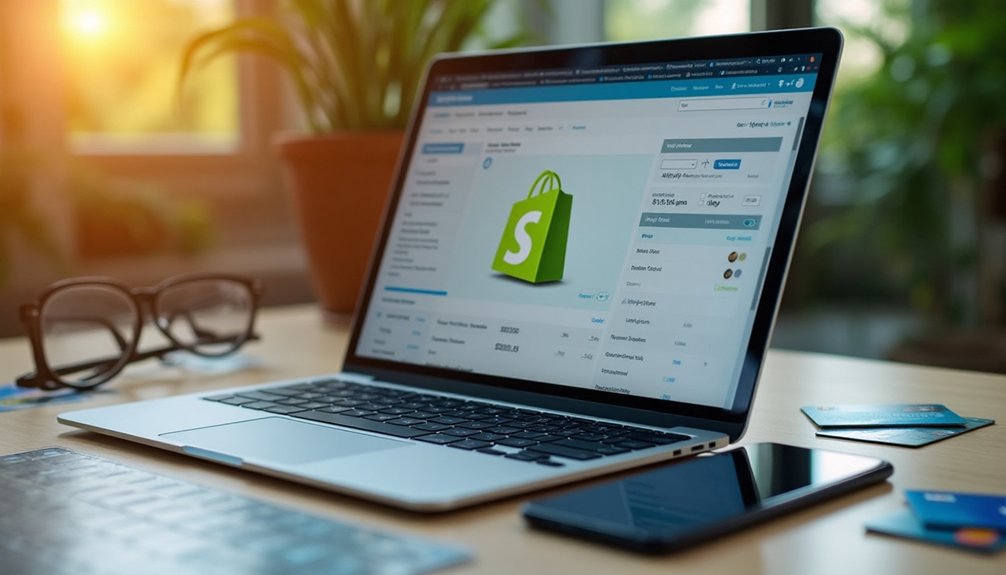When I first started my Shopify store, I quickly realized that choosing the right tools was crucial to my success. From selecting the perfect theme to incorporating essential apps, each decision impacted my store’s performance. I found that the right balance of functionality and aesthetics could make all the difference. So, what are the key tools that can help your store thrive and stand out in a competitive market? Let’s explore that.
Key Takeaways
- Choose a clean, mobile-responsive Shopify theme with customizable options to enhance the shopping experience.
- Utilize essential apps like Oberlo for dropshipping and Google Analytics for performance tracking.
- Implement marketing tools such as social media ads and email marketing to drive traffic and engage audiences.
- Offer multiple payment gateways, like Shopify Payments and PayPal, for a seamless checkout experience.
- Optimize inventory management with apps that provide real-time tracking and alerts for low stock levels.
Choosing the Right Shopify Theme

When I think about choosing the right Shopify theme, it’s clear that the design sets the tone for your entire store. A well-chosen theme makes your products shine and keeps customers engaged.
I look for clean layouts and easy navigation, making sure it aligns with my brand’s identity. If I’m selling handmade goods, I prefer a theme that feels warm and inviting.
It’s essential to consider mobile responsiveness too; shoppers are often on their phones. I’ve found that themes with customizable options allow me to tweak colors and fonts without needing to code.
Always preview the theme before committing—this helps me visualize how it’ll look in action. Ultimately, a great theme enhances the shopping experience and boosts sales.
Essential Apps for Enhanced Functionality

To enhance the functionality of your Shopify store, integrating essential apps is crucial for streamlining operations and improving customer experience.
I recommend starting with tools like Oberlo for easy dropshipping, which saves you from inventory hassles. Then there’s Shopify Email, perfect for managing your marketing campaigns directly within the platform.
You’ll want to consider a live chat app, like Tidio, as it fosters immediate customer interaction, boosting satisfaction and conversion rates. Additionally, adding a review app, such as Yotpo, can amplify trust with testimonials.
Lastly, don’t overlook analytics apps, like Google Analytics, to track your store’s performance and gain valuable insights. These tools are game-changers and will undoubtedly elevate your Shopify experience.
Marketing Tools to Drive Traffic

Having the right apps can set a solid foundation for your Shopify store, but once that’s in place, driving traffic is where the magic happens.
I’ve found that using social media platforms like Facebook and Instagram is essential for reaching new audiences. Paid ads can amplify your visibility, ensuring potential customers see your products.
Email marketing tools like Mailchimp help me engage with my audience, promoting specials and new arrivals directly to their inbox. Don’t underestimate SEO tools either; they’ve helped me optimize my store’s content to appear in search results.
Lastly, consider collaborating with influencers; their recommendations can convert their followers into your customers. By leveraging these marketing tools, you’ll steadily build a loyal customer base.
Payment Gateways for Seamless Transactions

While I’m focused on attracting customers to my Shopify store, ensuring they’ve a seamless payment experience is just as crucial. Choosing the right payment gateways can make a huge difference.
I’ve found that Shopify Payments is user-friendly and integrates effortlessly with my store, allowing customers to check out quickly. Additionally, I consider options like PayPal and Stripe for their reliability and widespread acceptance.
It’s vital to offer multiple payment methods to cater to different preferences. I also pay attention to transaction fees, as they can add up quickly.
Inventory Management Solutions

When running a Shopify store, managing your inventory is crucial for success.
I’ve found that using top inventory apps makes it easier to keep track of what’s in stock and what needs replenishing.
Real-time tracking features can also help you avoid running low or overstocking items, so let’s explore some of the best options available.
Top Inventory Apps
If you’re looking to streamline your Shopify store’s operations, choosing the right inventory management app is crucial. I’ve explored a few top apps that can make managing your stock a breeze.
One standout is TradeGecko, which offers seamless integration and comprehensive features, perfect for scaling businesses like mine.
Another great option is Stocky, ideal for Shopify POS users wanting to optimize their inventory decisions.
For those just starting, DEAR Inventory provides user-friendly tools with plenty of resources to guide you.
Lastly, QuickBooks Commerce integrates well with accounting, ensuring your finances and inventory are in sync.
Each of these apps can help you manage stock levels, reduce errors, and ultimately enhance your store’s efficiency.
Real-Time Tracking Features
As I dove into the world of inventory management, I quickly realized how essential real-time tracking features are for running a successful Shopify store.
These tools help me monitor stock levels instantly, reducing the risk of overselling or stockouts. By integrating my inventory with real-time tracking, I can make informed decisions about restocking and avoid lost sales due to unavailability.
Seeing trends in product movement allows me to respond to customer demand proactively.
Plus, I love receiving alerts for low stock levels, which keeps my products readily available without overstocking.
Real-time tracking not only streamlines my workflow but also enhances my customer experience, ensuring they get what they want when they want it.
Customer Support Tools for Improved Service

While managing a Shopify store, I’ve found that effective customer support tools are essential for creating a positive shopping experience. Tools like Zendesk and Freshdesk allow me to manage customer inquiries efficiently and ensure timely responses.
Implementing live chat options, like Tidio or Drift, has transformed my interaction with shoppers, providing instant support when they need it most.
Additionally, using email automation tools like Gorgias helps me streamline communication and maintain a personal touch with customers.
It’s crucial to have a robust FAQ section to address common concerns efficiently. By investing in these customer support tools, I’m able to enhance satisfaction, foster loyalty, and ultimately drive more sales in my Shopify store.
Conclusion
In conclusion, starting your Shopify store is an exciting journey, and leveraging the right tools can make all the difference. By choosing a user-friendly theme, integrating essential apps, utilizing effective marketing strategies, and ensuring smooth transactions and inventory management, you’ll set yourself up for success. Don’t forget about customer support tools to enhance the shopping experience. With these resources, you’ll be well-equipped to build your brand and grow your online presence. Let’s get started!







